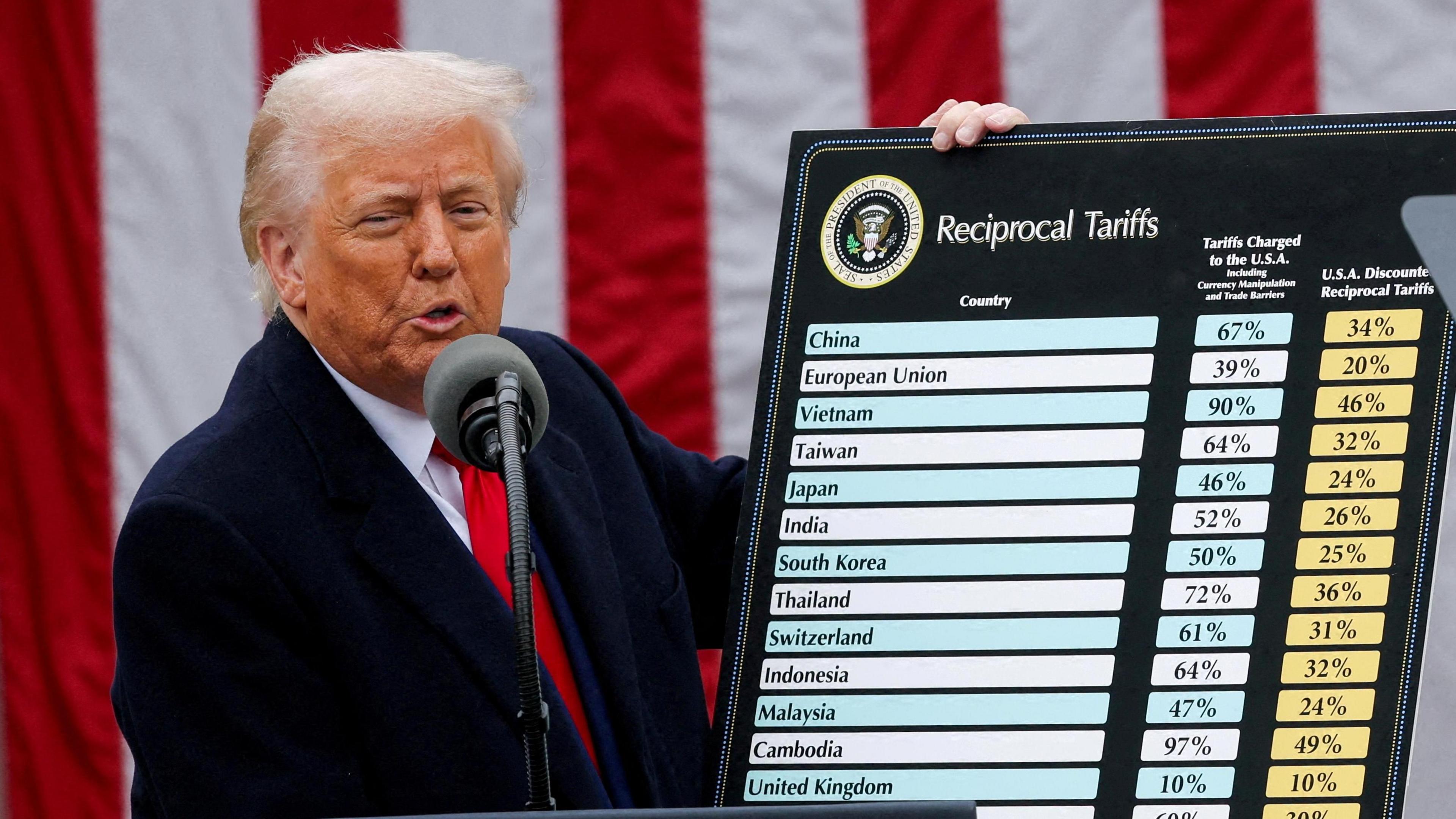Photo: BBC
On April 2, 2025, President Donald Trump took the stage in the White House Rose Garden, declaring it “Liberation Day.” According to Trump, this was the day America would reclaim its economic independence, the day the country would stop “enriching other nations” at its own expense.
The announcement? Sweeping new tariffs—perhaps the most aggressive trade policy shift in modern U.S. history.
Key Announcements and What They Mean
- 10% Universal Baseline Tariff:
- A blanket 10% tariff will be applied to all imported goods from every country.
- Intended to protect American industries and reduce dependence on foreign goods.
- Likely to increase costs for businesses and consumers as importers pass on the expense.
- Reciprocal Tariffs on Over 60 Countries:
- Some nations will face additional tariffs based on what they charge on U.S. exports.
- Examples include:
- China: 34%
- Taiwan: 32%
- India: 26%
- Japan: 24%
- European Union: 20%
- Vietnam: 46%
- South Korea: 25%
- Designed to level the playing field, but could lead to trade disputes and retaliatory tariffs.
- Elimination of Duty-Free Loopholes for Chinese Goods:
- The U.S. previously allowed shipments under $800 to enter duty-free.
- This loophole is now closed, meaning all Chinese imports will be subject to tariffs.
- Aimed at curbing the influx of cheap Chinese products, but will also raise costs for consumers and businesses reliant on these goods.
The administration framed this as a long-overdue correction to trade imbalances that have cost American jobs, weakened domestic manufacturing, and left the U.S. dependent on foreign nations for critical goods. However, critics—especially free trade advocates—warn that this move will drive up prices, slow economic growth, and invite retaliation from global trading partners.
Regardless of which side of the debate you’re on, one thing is clear: this policy will directly and profoundly impact multiple industries, including real estate.
How Tariffs Will Reshape the Real Estate Industry
Real estate doesn’t exist in a vacuum. It’s tied to materials, labor, and economic confidence—all of which are directly affected by trade policy. The introduction of these tariffs means significant shifts for investors, developers, homeowners, and renters alike.
1. Higher Costs for Construction and Renovation
A 10% across-the-board tariff—and even higher levies on key trading partners—means one thing for real estate developers and homebuilders: More expensive materials. The U.S. imports massive amounts of steel, lumber, electrical components, and plumbing fixtures from countries like China, Canada, and the EU. With tariffs in place, expect:
- Higher prices for new home construction
- Increased costs for renovations and remodels
- More expensive repairs for landlords and homeowners
This will make flipping homes costlier, drive up the price of new builds, and put pressure on contractors trying to maintain profit margins.
2. Supply Chain Disruptions and Project Delays
The construction industry already struggles with supply chain issues, and these tariffs won’t help. If foreign suppliers face new trade barriers, developers may see:
- Delays in commercial and residential construction
- Shortages of key building materials
- Higher demand for domestic suppliers, leading to backlogs and price hikes
For investors and developers, these disruptions can translate to longer project timelines and higher carrying costs—shrinking profit margins and making some projects financially unfeasible.
3. Rising Home Prices and Rents
When construction costs go up, home prices follow. Builders will pass increased costs onto buyers, making homeownership less affordable. Similarly, rental property investors facing pricier repairs and renovations may be forced to raise rents to maintain profitability. The end result?
- Fewer affordable housing options
- Higher rent for tenants
- More pressure on middle-class and first-time homebuyers
4. Impact on Real Estate Investors
For fix-and-flip investors, these changes are particularly concerning. Flippers rely on affordable renovation costs to turn a profit. If materials and labor costs spike, their margins shrink, making quick-turnaround projects riskier and potentially less attractive.
Additionally, higher overall home prices could slow down sales, making it harder to exit investments quickly. Investors may have to rethink their strategies, possibly shifting toward long-term rental holdings instead of short-term flips.
5. Commercial Real Estate May Struggle
Many businesses—especially retailers and manufacturers—rely on imported goods. If tariffs drive up costs, companies may struggle with shrinking profit margins, leading to reduced demand for commercial space. Office landlords, retail strip owners, and warehouse investors should all keep an eye on:
- Potential vacancies if businesses scale down operations
- Reduced leasing activity due to economic uncertainty
- Shifting demand patterns as businesses adapt to changing costs
Final Thoughts
April 2, 2025, may be known as “Liberation Day,” but for many in the real estate industry, it signifies the start of a period marked by adjustment and uncertainty. While the administration views tariffs as a means to rebuild American industry, the short-term effects could entail rising costs, supply chain disruptions, and higher prices for both homebuyers and renters.
The pressing question now is: How long will these tariffs endure? If they are merely a negotiation tactic to bring trading partners to the table, we might see adjustments in the near future. However, if they become a long-term aspect of U.S. trade policy, the real estate industry—and the economy as a whole—will need to adapt in significant ways.
For now, investors, developers, and homeowners should prepare for change. Stay informed, adjust strategies as needed, and be ready for a new era in real estate shaped by global trade policies.




